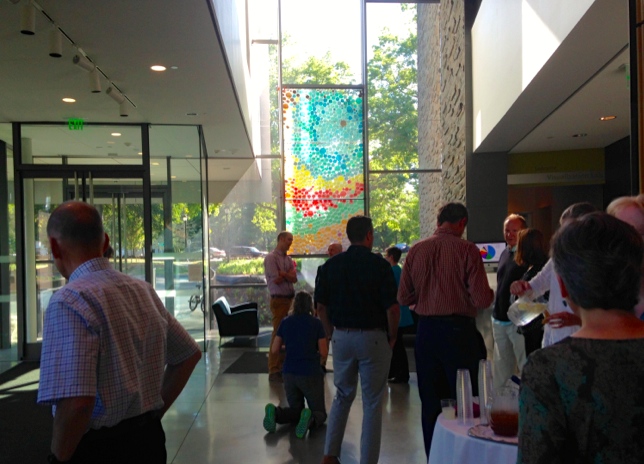From afar it looks like a regular stained glass window, but as you move closer you see a mosaic of uniform circles, within which are a myriad of irregular lines and shapes. These circles are actually petri dishes and the different lines and shapes within them are colonies of several different types of microbes – living organisms!
This installation, located in the Bridge Building for Laboratory Sciences, titled “20/20 Biome,” was put together by Richard Jones of Vassar’s Earth Science Department. It was inspired by biologist Rob Dunn’s book, “The Wild Life Of Our Bodies: Predators, Parasites, and Partners That Shape Who We Are Today,” which incoming freshmen were required to read and share their ideas about over the summer.
When they arrived on campus, the freshmen were then invited to swab different parts of their bodies to contribute microbes for the display. Each petri dish represents a single freshman. The different types of cultures and striations made by the microbes are as unique as the individuals from which they came. Additionally, each petri dish is dyed a different color, which is representative of one of the nine dorms first year students live in: at the bottom are pink petri dishes representing the newest dorm, Noyes, and at the very top the blue ones representing the oldest dorm, Main. Towards the top, there is also a gold circular object located between the petri dishes, which represent Vassar as a whole.
On Monday afternoon, a reception was held in honor of the “20/20 Biome” at the Bridge Building. In attendance were students and professors from a variety of disciplines as well as Dunn himself. Around the display were also screens with quotes from the freshman, as well as some interesting statistics about their class. The installation itself prompted many conversations about Vassar’s interdisciplinary programs as well as topics relating to Dunn’s work. Attendees agreed that it was a unique way of bridging the arts and sciences at Vassar.
–Alicia Lewis ’16, CAAD Student


